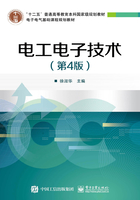
2.4 RL电路的暂态过程
电机、电磁铁、电磁继电器等电磁元器件都可等效为RL的串联电路。因为L是储能元件,所以RL电路在换路时也可能会产生暂态过程。
2.4.1 RL电路的零输入响应
在图2.8所示的RL电路中,换路前开关合在1端,电路已处于稳态。 时将开关由1合到2,产生换路。换路后,电路的电源激励为零,在电感的初始储能的作用下,电路将产生零输入响应。
时将开关由1合到2,产生换路。换路后,电路的电源激励为零,在电感的初始储能的作用下,电路将产生零输入响应。

图2.8 RL电路的零输入响应
根据换路定则可知,电感中电流的初始值为

换路后电路的KVL方程

(2.18)
上式与RC电路的零输入响应的微分方程形式相同,参照式(2.2)的解法及结果,可得

代入初始条件,即 ,则
,则 。
。
所以,电路中微分方程的解为

(2.19)
由此可得,电感上电流的衰减规律与电容上电压的衰减规律是相同的,都是随时间按指数规律变化的。波形如图2.9所示,由初始值I0按指数规律变化到新的稳态值0,变化的速度取决于时间常数 。由式(2.19)可知,RL电路的时间常数为
。由式(2.19)可知,RL电路的时间常数为

(2.20)

图2.9 RL电路的零输入响应波形
当电阻的单位为Ω(欧姆),电感的单位为H(亨利)时, 的单位是s(秒)。
的单位是s(秒)。
 的大小决定了过渡过程的快慢,即暂态过程的长短。
的大小决定了过渡过程的快慢,即暂态过程的长短。 越大,
越大, 和
和 衰减得越慢,暂态过程越长。当经过了一个
衰减得越慢,暂态过程越长。当经过了一个 后,
后, 衰减为初始值的36.8%,即
衰减为初始值的36.8%,即

理论上,当 趋近于∞时,电路才达到新的稳定状态;而实际上,经过
趋近于∞时,电路才达到新的稳定状态;而实际上,经过 后,就可以认为过渡过程结束,电路已达到新的稳定状态了。
后,就可以认为过渡过程结束,电路已达到新的稳定状态了。
在图2.8所示的一阶RL电路中,我们已求得电感电流的初始值 ,稳态值
,稳态值 ,时间常数
,时间常数 ,代入三要素法的一般式中,可得
,代入三要素法的一般式中,可得

(2.21)
可以看出,用三要素法求得的暂态响应与用经典法得到的式(2.19)相同。因此一阶RL电路的暂态响应也可以用三要素法求解。在一阶RL电路中,时间常数 ,式中
,式中 是换路后的电路中从电感元件两端看进去的无源二端网络(将理想电压源短路,理想电流源开路)的等效电阻。
是换路后的电路中从电感元件两端看进去的无源二端网络(将理想电压源短路,理想电流源开路)的等效电阻。
根据元件特性,可求出如图2.8所示电路中电感电压的变化规律,即

(2.22)
 的波形图如图2.9所示。
的波形图如图2.9所示。
可以用RL串联电路作为线圈的电路模型,在图2.8中,若用开关将线圈从电源断开而未加以短路,这时由于电流变化率 很大,因此将在线圈两端产生非常大的感应电动势,这个感应电动势可能将开关两个触点间的空气击穿而造成电弧以延续电流的流动,这种现象可能会造成设备的损坏和人员的伤害。所以,在将线圈从电源断开的同时,必须将其短路或接入一个低值泄放电阻。此泄放电阻的数值不宜过大,否则,在换路的瞬间将在线圈两端感应出过高电压。如果在线圈两端原来接着电压表(其内阻很大),在开关断开前必须先将其去掉,以免引起过电压而损坏电表。
很大,因此将在线圈两端产生非常大的感应电动势,这个感应电动势可能将开关两个触点间的空气击穿而造成电弧以延续电流的流动,这种现象可能会造成设备的损坏和人员的伤害。所以,在将线圈从电源断开的同时,必须将其短路或接入一个低值泄放电阻。此泄放电阻的数值不宜过大,否则,在换路的瞬间将在线圈两端感应出过高电压。如果在线圈两端原来接着电压表(其内阻很大),在开关断开前必须先将其去掉,以免引起过电压而损坏电表。
〖例2.4〗图2.10所示为直流电机的励磁电路。已知:U=220V,L=10H, ,
, ,R'=1kΩ。开关断开电源时与泄放电阻
,R'=1kΩ。开关断开电源时与泄放电阻 接通。求:(1)负载两端的初始电压
接通。求:(1)负载两端的初始电压 。(2)
。(2) 多大时,能保证
多大时,能保证 不超过其额定电压220V?(3)写出
不超过其额定电压220V?(3)写出 时
时 的表达式。(4)根据(2)中所选的
的表达式。(4)根据(2)中所选的 ,开关接通
,开关接通 后多长时间,线圈才能将所储存的能量释放掉95%?
后多长时间,线圈才能将所储存的能量释放掉95%?

图2.10 例2.4电路
解:(1)
 时,负载两端电压大小为
时,负载两端电压大小为 在
在 和
和 上产生的压降之和。
上产生的压降之和。

(2)如果使 不超过220V,则
不超过220V,则

得 
(3)


(4)设磁能泄放掉95%时的 为
为 ,则
,则


代入 表达式,得
表达式,得


2.4.2 RL电路的零状态响应
电路如图2.11所示。换路前,电感没有初始储能,所以,电感电流的初始值为


图2.11 RL电路的零状态响应
换路后开关闭合,电路达到新的稳态时,电流的稳态值为

电路的时间常数 ,根据三要素法的一般式,可得出RL电路的零状态响应为
,根据三要素法的一般式,可得出RL电路的零状态响应为

(2.23)
从上式中可以看出,iL也是由稳态分量和暂态分量两部分叠加而成的。其变化的速度依然取决于时间常数 。波形如图2.12(a)所示。
。波形如图2.12(a)所示。
根据(2.23)和电路的基本定律,可求得电路中 时,电感元件和电阻元件两端的电压为
时,电感元件和电阻元件两端的电压为

(2.24)

(2.25)
它们的波形图如2.12(b)所示。

图2.12 RL电路的零状态响应的波形
2.4.3 RL电路的全响应
图2.13所示的RL串联电路中,电源电压为U,为t=0时,开关闭合。

图2.13 RL电路的全响应
换路前,电路已处于稳态,电感电流的初始值为

换路后,开关闭合,电路达到新的稳态时,电感电流的稳态值为

电路的时间常数 ,将初始值、稳态值和时间常数代入三要素法的公式中,可得
,将初始值、稳态值和时间常数代入三要素法的公式中,可得

(2.26)
可见,全响应的结果为零输入和零状态响应的叠加。
与RC电路一样,在分析复杂一些的RL电路的暂态过程时,可应用戴维南定理,将电感支路以外的部分电路做戴维南等效,简化电路的结构后,再进行电路分析。
【思考与练习】
2-4-1 图2.14所示的电路中,与R、L线圈并联的是一个二极管。设二极管的正向电阻为零,反向电阻为无穷大。试问:二极管在此起何作用?

图2.14 思考与练习2-4-1的电路